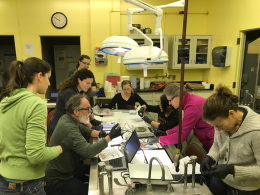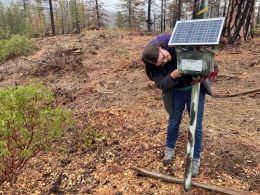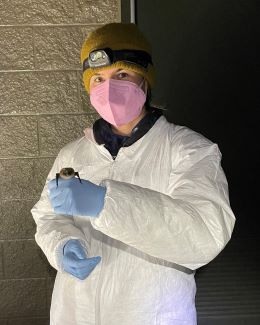Bat surveillance crew

Screening for White-nose Syndrome

Acoustic detector station

Scientist Amanda Kindel with Myotis bat
If California’s hibernating bat species make it through this winter with a full, undisturbed hibernation cycle, there are a few CDFW scientists who may be sleeping soundly as well.
CDFW’s bat conservation team has ramped up its statewide surveying efforts in the past few years. The team is amassing a large amount of data on bat activity. Some of the work is geared toward general species conservation. But most of it has a very intentional focus: staying ahead of White-nose Syndrome (WNS), a disease that has wreaked havoc on East Coast and Midwest bat populations.
WNS is a fungal disease that grows on bats during winter hibernation and can result in a white fuzzy appearance on their muzzle, ears and wings. The disease causes bats to arouse more than usual during hibernation and consequently burn up fat reserves needed to sustain them through winter. They can ultimately end up starving to death.
More than six million bats have died from WNS, and the disease can kill 80 to 90 percent of bats in a colony during hibernation. In some bat species, the mortality rate for WNS can approach 100 percent.
In the United States, WNS was first found in 2006 in upstate New York. It likely traveled here from Eurasia. In 2016, hikers in Washington found a sick bat on a trail and took it to a wildlife rehabilitation center for treatment. It tested positive for WNS and died shortly thereafter. Scientists soon found two more bats that tested positive for WNS. The disease continued to spread.
In California, scientists detected low levels of the fungus that causes WNS in 2018 in Plumas County. While they have continued to detect low levels of the fungus since then, they haven’t found the disease. However, WNS surveillance in Texas and elsewhere has revealed a concerning pattern: WNS has taken a foothold in bat populations within two to three years of the fungus being detected. California is home to 25 bat species, and at least nine of them are deep-hibernating bats susceptible to the disease.
“It’s somewhat reassuring that we haven’t seen the disease in California and only low-level detections of the fungus. But it’s also mystifying because we kind of expected to be seeing the disease by now,” said CDFW Wildlife Biologist Dr. Scott Osborn.
The CDFW team is currently in year three of its White-Nose Syndrome Response Project. The team consists of Osborn, Senior Wildlife Veterinarian Dr. Deana Clifford, and Scientific Aids Amelia Tauber, Amanda Kindel and Dylan Winkler. Additionally, volunteers assist with field work.
Over the past two years, the team has sampled for the fungus at 11 sites statewide. CDFW also partners with the National Park Service on bat surveillance. Between the two organizations, surveillance for WNS occurs throughout much of California.
The team is also setting up a network of detector stations for bats. The stations record bat calls on a nightly basis and will help scientists identify activity levels of various bat species. Scientists can then correlate activity level changes with detections of WNS or the fungus that causes it.
“The whole idea is if WNS comes in and starts affecting susceptible species, we should see their level of activity drop off compared to other species that aren’t susceptible to WNS,” said Osborn.
The team currently has eight stations in and around Plumas and Tehama counties, and another four on the north coast. They are scheduled to install four more stations in the northern Sierra this month.
“We’ve got this pretty massive effort to collect data on bat activity. It’s exciting. The data will not only help us detect the impact of WNS if it ever shows up, but it’s also giving us really important information on the timing of activity of various bat species, and bat community composition. It’s possible that in the long run we could use the data to detect impacts from climate change – for example if bats are becoming active earlier in the year due to warming or have to change their activity levels due to heat,” said Osborn.
Since 2009, a national interagency team has been working on WNS response. In the past few years, the team has developed several treatment and management techniques which are starting to be implemented in bat habitats. Outside of California, scientists are testing a vaccine that is typically applied to bats during their active season. The goal of the vaccine is to make bats less susceptible to the fungus when they go back into hibernation. Scientists are also working on a probiotic spray that can be applied to bat roosts during active season. Microbes in the probiotic spray appear to make bats less susceptible to WNS. Another experimental treatment involves shining ultraviolet light into a hibernation site to reduce its fungal load.
Not all of the new treatments are applicable to most California bat populations, which don’t typically congregate in large numbers in hibernation sites. Nevertheless, some of the treatments offer hope for reducing the devastating effects of WNS. Meanwhile, CDFW’s bat conservation team will continue working to stay ahead of the disease.
“It’s important for us to understand what’s going on with WNS so we can implement some of these measures if it is ever detected in California. Bats are beneficial to the ecosystem by helping control pests on agricultural lands and elsewhere. They distribute nutrients to the environment by processing insects. They’re fascinating creatures,” said Osborn.
###
Media contact:
Ken Paglia, CDFW Communications